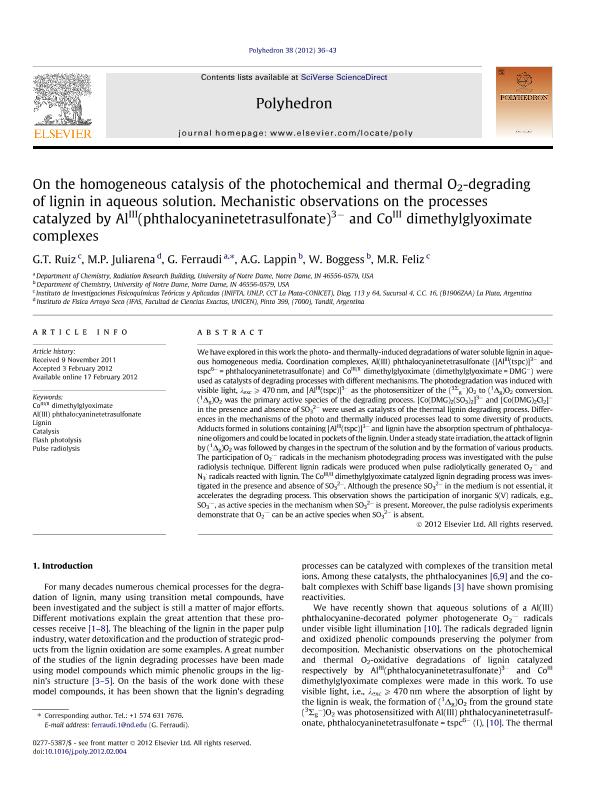Artículo
On the homogeneous catalysis of the photochemical and thermal O 2-degrading of lignin in aqueous solution. Mechanistic observations on the processes catalyzed by Al III(phthalocyaninetetrasulfonate) 3- and Co III dimethylglyoximate complexes
Ruiz, Gustavo Teodosio ; Juliarena, María Paula
; Juliarena, María Paula ; Ferraudi, G. J.; Lappin, A. G.; Bogges,W.; Feliz, Mario R.
; Ferraudi, G. J.; Lappin, A. G.; Bogges,W.; Feliz, Mario R.
 ; Juliarena, María Paula
; Juliarena, María Paula ; Ferraudi, G. J.; Lappin, A. G.; Bogges,W.; Feliz, Mario R.
; Ferraudi, G. J.; Lappin, A. G.; Bogges,W.; Feliz, Mario R.
Fecha de publicación:
05/2012
Editorial:
Pergamon-Elsevier Science Ltd
Revista:
Polyhedron
ISSN:
0277-5387
Idioma:
Inglés
Tipo de recurso:
Artículo publicado
Clasificación temática:
Resumen
We have explored in this work the photo- and thermally-induced degradations of water soluble lignin in aqueous homogeneous media. Coordination complexes, Al(III) phthalocyaninetetrasulfonate ([Al III(tspc)] 3- and tspc 6- = phthalocyaninetetrasulfonate) and Co III/II dimethylglyoximate (dimethylglyoximate = DMG -) were used as catalysts of degrading processes with different mechanisms. The photodegradation was induced with visible light, λ exc ≥ 470 nm, and [Al III(tspc)] 3- as the photosensitizer of the ( 3Σ g -)O 2 to ( 1Δ g)O 2 conversion. ( 1Δ g)O 2 was the primary active species of the degrading process. [Co(DMG) 2(SO 3) 2] 3- and [Co(DMG) 2Cl 2] - in the presence and absence of SO 3 2- were used as catalysts of the thermal lignin degrading process. Differences in the mechanisms of the photo and thermally induced processes lead to some diversity of products. Adducts formed in solutions containing [Al III(tspc)] 3- and lignin have the absorption spectrum of phthalocyanine oligomers and could be located in pockets of the lignin. Under a steady state irradiation, the attack of lignin by ( 1Δ g)O 2 was followed by changes in the spectrum of the solution and by the formation of various products. The participation of O 2 ·- radicals in the mechanism photodegrading process was investigated with the pulse radiolysis technique. Different lignin radicals were produced when pulse radiolytically generated O 2 ·- and N 3 · radicals reacted with lignin. The Co III/II dimethylglyoximate catalyzed lignin degrading process was investigated in the presence and absence of SO 3 2-. Although the presence SO 3 2- in the medium is not essential, it accelerates the degrading process. This observation shows the participation of inorganic S(V) radicals, e.g., SO 3 ·-, as active species in the mechanism when SO 3 2- is present. Moreover, the pulse radiolysis experiments demonstrate that O 2 ·- can be an active species when SO 3 2- is absent.
Archivos asociados
Licencia
Identificadores
Colecciones
Articulos(CCT - TANDIL)
Articulos de CTRO CIENTIFICO TECNOLOGICO CONICET - TANDIL
Articulos de CTRO CIENTIFICO TECNOLOGICO CONICET - TANDIL
Articulos(INIFTA)
Articulos de INST.DE INV.FISICOQUIMICAS TEORICAS Y APLIC.
Articulos de INST.DE INV.FISICOQUIMICAS TEORICAS Y APLIC.
Citación
Ruiz, Gustavo Teodosio; Juliarena, María Paula; Ferraudi, G. J.; Lappin, A. G.; Bogges,W.; et al.; On the homogeneous catalysis of the photochemical and thermal O 2-degrading of lignin in aqueous solution. Mechanistic observations on the processes catalyzed by Al III(phthalocyaninetetrasulfonate) 3- and Co III dimethylglyoximate complexes; Pergamon-Elsevier Science Ltd; Polyhedron; 38; 1; 5-2012; 36-43
Compartir
Altmétricas



